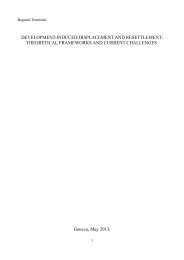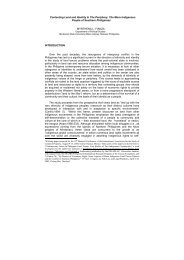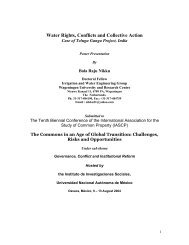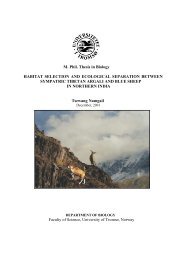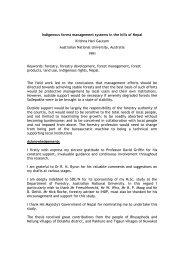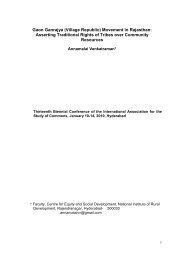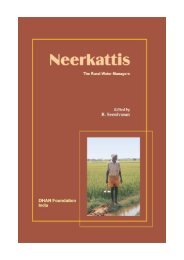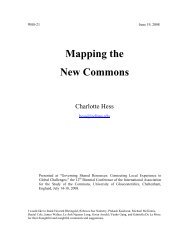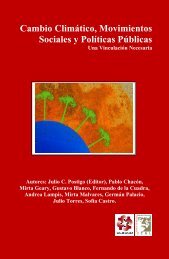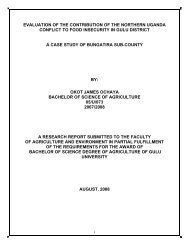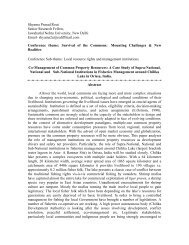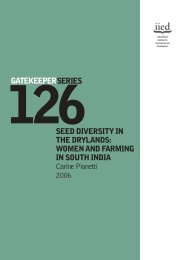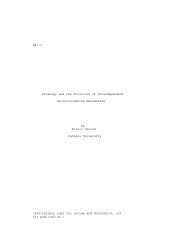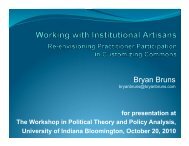Occupying the Land - Digital Library Of The Commons
Occupying the Land - Digital Library Of The Commons
Occupying the Land - Digital Library Of The Commons
You also want an ePaper? Increase the reach of your titles
YUMPU automatically turns print PDFs into web optimized ePapers that Google loves.
ask permission to use <strong>the</strong> traps from those who built <strong>the</strong>m. Gun<strong>the</strong>r (1927:199) reportedthat Clallam salmon traps were owned by "<strong>the</strong> chief of <strong>the</strong> village, who tends it at night,leaving it during <strong>the</strong> day-time for his poor relatives who have not traps of <strong>the</strong>ir own."Deer-nets and deer-pits were likewise owned property. <strong>The</strong>ir operation was directed by<strong>the</strong> owner, but sites where <strong>the</strong>y were situated were not necessarily owned. As notedpreviously, aerial duck-nets were owned by families, as were <strong>the</strong> poles used to erect <strong>the</strong>m,but <strong>the</strong> sites where <strong>the</strong>y were erected were used by several tribes in common (Suttles1951:72). Suttles (1990:459), however, suggests that such sites were formerlyindividually owned.<strong>The</strong>se ownership traditions were closely intertwined with seasonal rounds, <strong>the</strong>movements of people over <strong>the</strong> harvest season from one site to ano<strong>the</strong>r where <strong>the</strong>y hadcustomary or culturally recognized rights. Jenness (1934-1935: 70) reported, "Wintervillage sites were situated within an area where people obtained large portions of <strong>the</strong>irfood and materials, and which <strong>the</strong>y identified using names in <strong>the</strong>ir own language. Agroup’s territory is commonly identified by applying <strong>the</strong> suffix /-ulh/ meaning ’of orbelonging to’... One’s territory is also <strong>the</strong> landscape imbued with oral tradition...Ownership was expressed individually as <strong>the</strong> right to use resources in a multitude ofareas, and was independent of proprietary feelings for one's tribal territory.”<strong>The</strong> East Saanich [Tsawout], <strong>the</strong> Songish [Legwungen] and those near Chemainusfollowed practically <strong>the</strong> same routine as <strong>the</strong> West Saanich; <strong>the</strong>y all left <strong>the</strong>ir main villagesin <strong>the</strong> middle of summer and netted sockeye and humpbacked salmon on <strong>the</strong> mainland,off <strong>the</strong> mouth of <strong>the</strong> Fraser River, as reported by Jenness (1934-1935:18). Also, "If <strong>the</strong>wea<strong>the</strong>r was warm, many of <strong>the</strong> [Saanich] people left <strong>the</strong> village and camped near <strong>the</strong>ircamas grounds on San Juan Island, using for shelter ei<strong>the</strong>r a few boards taken from <strong>the</strong>irhouse, or rush huts (Jenness 1934-1935: 7). <strong>The</strong> Suneymexw (“Solachwan”) people of <strong>the</strong>Nanaimo area, according to Jenness (1934-1935: 9), occupied <strong>the</strong>ir village until aboutApril, “when <strong>the</strong>y joined <strong>the</strong> o<strong>the</strong>rs in moving out to False Narrows and Gabriola Islandto fish for cod, grilse and o<strong>the</strong>r species, to hunt seals and seal-lions and to ga<strong>the</strong>r clamsand camas; for every family had its own bed of camas on Gabriola Island.”<strong>The</strong> Cowichan Halkomelem, according to Jenness (1934-1935: 8), had no fishing rightson <strong>the</strong> mainland, but only over <strong>the</strong> waters immediately adjacent to <strong>the</strong>ir shore and aroundMayne and Saltspring Islands. Jenness added that at Point Roberts, on <strong>the</strong> Mainland southof Tsawwassen, where Saanich families went to fish, each family dried its fish, year afteryear, in <strong>the</strong> same spot, and <strong>the</strong>y left <strong>the</strong>ir stone net-sinkers at this location to be used <strong>the</strong>following year. <strong>The</strong>re was a careful distribution of fish with a special counting system(Jenness 1934-1935: 18). Actually, <strong>the</strong>re are o<strong>the</strong>r reports that <strong>the</strong> Cowichan did haverights to harvest sites on <strong>the</strong> Mainland. Arvid Charlie (pers. comm., 1999) stated that <strong>the</strong>people from Cowichan not only had property and resource harvesting sites on <strong>the</strong> GulfIslands, but that <strong>the</strong>y owned an island near Port Moody along <strong>the</strong> Fraser River, and went<strong>the</strong>re specifically to harvest cat-tails. It seems unlikely that <strong>the</strong>y would not have taken thisopportunity to fish as well.In any case, as noted by Kennedy (1993), Jenness (1934-1935), Suttles (1990) and o<strong>the</strong>rs,<strong>the</strong>re was such an extensive network of affinal ties from inter-village and inter-nationmarriages among <strong>the</strong> Central Coast Salish, that most people had relations on whom <strong>the</strong>y10



